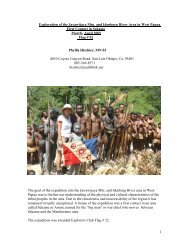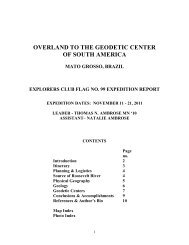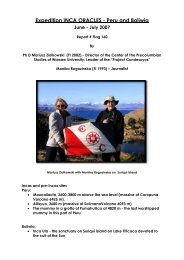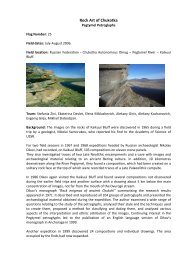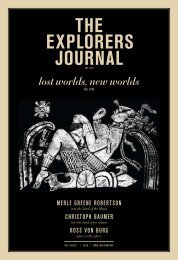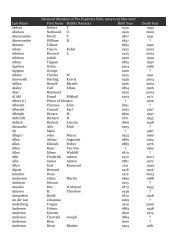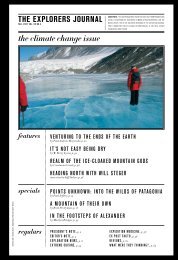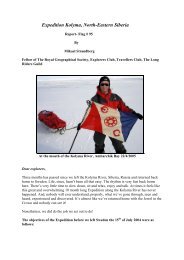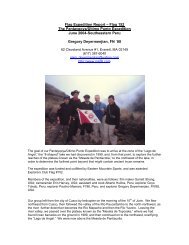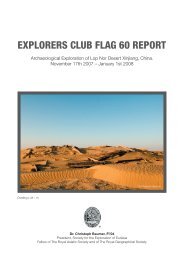the explorers journal - The Explorers Club
the explorers journal - The Explorers Club
the explorers journal - The Explorers Club
You also want an ePaper? Increase the reach of your titles
YUMPU automatically turns print PDFs into web optimized ePapers that Google loves.
of a Russian Soyuz spacecraft, launching from<br />
<strong>the</strong> Baikonur Cosmodrome in Kazakhstan. During<br />
Expedition 10, we performed two spacewalks,<br />
which offered me a unique opportunity to put on<br />
a Russian Orlan spacesuit and to compare <strong>the</strong>ir<br />
system with ours.<br />
i n t e r n a t i o n a l a p p r o a c h t o<br />
s p a c e E x p l o r a t i o n<br />
It was interesting for me to note that cultural differences<br />
extend into technical arenas. I found<br />
<strong>the</strong> Russian space hardware and methods to be<br />
effective, safe, and reliable. However, <strong>the</strong>ir approach<br />
is totally different from ours in <strong>the</strong> West.<br />
We Americans tend to engineer our systems to optimize<br />
performance. For example, even <strong>the</strong> power<br />
tool that NASA developed includes a microprocessor.<br />
<strong>The</strong> Russians, on <strong>the</strong> o<strong>the</strong>r hand, use simple,<br />
often mechanical systems. <strong>The</strong> analogy I use is that<br />
American hardware is like a luxury car: comfortable,<br />
with many amenities, but also complicated.<br />
Russian hardware is like that old pickup truck:<br />
uncomfortable, free of amenities, but it starts and<br />
will get you to point B every time.<br />
When China launched its first astronaut, Yang<br />
Liwei, into space in October 2003, it became<br />
only <strong>the</strong> third nation in <strong>the</strong> world capable of human<br />
spaceflight. Three years later, I became<br />
<strong>the</strong> first American to be allowed to visit <strong>the</strong><br />
Astronaut Center of China (ACC), in Beijing.<br />
Over a series of visits <strong>the</strong>re, I met <strong>the</strong> ACC director,<br />
Chen Shanguang, and astronauts Yang<br />
Liwei, Fei Junlong, Nie Haisheng, and China’s<br />
first spacewalker, Zhai Zhigang. I was impressed<br />
with China’s space program, which has leveraged<br />
Russian technology and added sophistication in<br />
what appears to be a blend of <strong>the</strong> Russian and<br />
American engineering philosophies. Having flown<br />
only three crewed space missions, China lacks<br />
operational experience, not technological ability.<br />
M a g i c o f S p a c e f l i g h t<br />
Spaceflight is a magical, almost surreal experience.<br />
It is this basis that forms <strong>the</strong> special bond<br />
between astronauts and cosmonauts of all countries.<br />
What’s <strong>the</strong> best part Looking back at <strong>the</strong><br />
Earth and taking in <strong>the</strong> stunning beauty of our<br />
planet and being able to observe <strong>the</strong> same places<br />
on our planet throughout <strong>the</strong> seasons.<br />
A long mission to <strong>the</strong> ISS is quite different from<br />
a two-week shuttle flight. Perhaps a good analogy<br />
is <strong>the</strong> comparison of a marathon to a sprint. Just<br />
as <strong>the</strong> crew settles into a comfortable groove after<br />
four to six weeks, so does <strong>the</strong> human body. <strong>The</strong><br />
fluid shift from <strong>the</strong> lower extremities, which give<br />
people a “full-headed” feeling, subsides, as do<br />
o<strong>the</strong>r more subtle changes.<br />
<strong>The</strong>re’s nothing quite like living and working in<br />
microgravity. And as <strong>the</strong> largest space structure<br />
ever built, <strong>the</strong> ISS is <strong>the</strong> premier microgravity<br />
laboratory and thus presents an ideal environment<br />
in which to explore a host of research possibilities,<br />
including <strong>the</strong> development of future vaccines,<br />
which would improve life both on and off of <strong>the</strong><br />
Earth and beyond (see page 31).<br />
T h e S p a c e S h u t t l e P r o g r a m<br />
m a r k s a m i l e s t o n e<br />
Originally conceived as a low-cost, reusable orbital<br />
“truck,” <strong>the</strong> Space Shuttle was intended to fly almost<br />
weekly and offer inexpensive space access<br />
to both government and commercial users. It has<br />
been flying now for nearly three decades, but after<br />
134 flights and two fatal accidents, it has never approached<br />
<strong>the</strong> original goals on cost and turnaround.<br />
It is expensive to operate (around $500 million<br />
per mission) and carries more risk than originally<br />
thought. NASA’s own estimates place <strong>the</strong> fatality<br />
risk on <strong>the</strong> shuttle around one in one hundred.<br />
Never<strong>the</strong>less, it has been a magnificent flying<br />
machine. <strong>The</strong>re has been no o<strong>the</strong>r vehicle like it.<br />
It launches like a rocket and <strong>the</strong>n becomes an<br />
orbital platform capable of deploying satellites;<br />
supporting scientific instruments, investigations,<br />
and spacewalking astronauts; and performing<br />
rendezvous and docking with space stations. It<br />
<strong>the</strong>n reenters <strong>the</strong> Earth’s atmosphere to land on a<br />
runway like an airplane. Twenty-nine years of operations<br />
have produced numerous achievements,<br />
including <strong>the</strong> deployment and servicing of <strong>the</strong><br />
Hubble Space Telescope, <strong>the</strong> construction and<br />
support of <strong>the</strong> ISS, <strong>the</strong> rescue of several satellites,<br />
and <strong>the</strong> conducting of thousands of scientific experiments.<br />
We have learned much from <strong>the</strong> shuttle<br />
experience, both in space technology and engineering,<br />
as well as in operations. <strong>The</strong>se lessons<br />
<strong>the</strong> <strong>explorers</strong> <strong>journal</strong>



